Mechanical and Shape Recovery Characterization of MWCNTs/HNTs-Reinforced Thermal-Responsive Shape-Memory Polymer Nanocomposites
Abstract
1. Introduction
2. Materials, Experimental and Characterization Procedure
2.1. Shape-Memory Polymer and Reinforcements
2.2. Preparation of Specimens for Various Characterizations
2.3. Differential Scanning Calorimetry (DSC) Test
2.4. Tensile Test
2.5. Flexural Test
2.6. Shape Recovery Test and Flexural Tests for Multiple Cycles
2.7. Impact Test
3. Results and Discussions
3.1. Differential Scanning Calorimetry (DSC) Test Result
3.2. Tensile Test Results
3.3. Flexural Test Results
3.4. Flexural Test Results for Repeated Cycles
3.5. Shape Recovery Results
3.6. Impact Test Results
4. Conclusions
- The tensile strength and elongation percentage varied enormously with the addition of both MWCNTs and HNTs. The tensile strength increased significantly, and the percentage of elongation decreased with an increase in the weight percentage of reinforcement.
- SMPU reinforced with 0.5 wt% HNTs gave 22.4 MPa tensile strength, which was 5% less than the tensile strength of SMPU reinforced with 1 wt% MWCNTs.
- At a given weight percentage of reinforcement, SMPU reinforced with HNTs exhibited a higher flexural strength than SMPU reinforced with MWCNTs.
- There was a minor increase in tensile strength and flexural strength of SMPU reinforced with HNTs during the increase in weight percentage from 0.5 to 1.
- A significant drop in flexural strength could be observed while doing the flexural test for repeated cycles. The drop was higher in the case of SMPU reinforced with HNTs compared to SMPU reinforced with MWCNTs.
- At both considered weight percentages of reinforcements, there existed only a five-percent difference in impact strength of specimens reinforced with MWCNTs and HNTs.
- The time required for the shape recovery was less in the case of SMPU reinforced with MWCNTs (least at 1 wt%). Further, it was evident from the shape recovery curves that the shape recovery in specimens reinforced with MWCNTs was faster.
Author Contributions
Funding
Institutional Review Board Statement
Informed Consent Statement
Data Availability Statement
Acknowledgments
Conflicts of Interest
Abbreviations
| SMPU | Shape-memory polyurethane |
| MWCNTs | Multiwalled carbon nanotubes |
| HNTs | Halloysite nanotubes |
| SMPs | Shape-memory polymers |
| SMPPs | Shape-memory polymer pellets |
| Angle of the sample in undeformed/permanent shape | |
| Angle of the sample in deformed/temporary shape |
References
- Lendlein, A.; Kelch, S. Shape-memory polymers as stimuli-sensitive implant materials. Clin. Hemorheol. Microcirc. 2005, 32, 105–116. [Google Scholar]
- Rousseau, I.A. Challenges of shape memory polymers: A review of the progress toward overcoming SMP’s limitations. Polym. Eng. Sci. 2008, 48, 2075–2089. [Google Scholar] [CrossRef]
- Sokolowski, W.; Metcalfe, A.; Hayashi, S.; Yahia, H.; Raymond, J. Medical applications of shape memory polymers. Biomed. Mater. 2007, 2, s23–s27. [Google Scholar] [CrossRef]
- Kunzelman, J.; Chung, T.; Mather, P.T.; Weder, C. Shape memory polymers with built-in threshold temperature sensors. J. Mater. Chem. 2008, 18, 1082–1086. [Google Scholar] [CrossRef]
- Liu, C.; Qin, H.; Mather, P. Review of progress in shape-memory polymers. J. Mater. Chem. 2007, 16, 1543–1558. [Google Scholar] [CrossRef]
- Pilate, F.; Toncheva, A.; Dubois, P.; Raquez, J.-M. Shape-memory polymers for multiple applications in the materials world. Eur. Polym. J. 2016, 80, 268–294. [Google Scholar] [CrossRef]
- Ahmad, M.; Luo, J.; Miraftab, M. Feasibility study of polyurethane shape-memory polymer actuators for pressure bandage application. Taylor Fr. 2012, 13, 015006. [Google Scholar] [CrossRef]
- An, Y.; Okuzaki, H. Novel electro-active shape memory polymers for soft actuators. Jpn. J. Appl. Phys. 2020, 59, 061002. [Google Scholar] [CrossRef]
- Meng, H.; Li, G. A review of stimuli-responsive shape memory polymer composites. Polymer 2013, 54, 2199–2221. [Google Scholar] [CrossRef]
- Liu, Y.; Lv, H.; Lan, X.; Leng, J.; Du, S. Review of electro-active shape-memory polymer composite. Compos. Sci. Technol. 2009, 69, 2064–2068. [Google Scholar] [CrossRef]
- Habault, D.; Zhang, H.; Zhao, Y. Light-triggered self-healing and shape-memory polymers. Chem. Soc. Rev. 2013, 42, 7244–7256. [Google Scholar] [CrossRef]
- Namathoti, S.; Ravindra Kumar, V.M.; Rama Sreekanth, P.S. A review on progress in magnetic, microwave, ultrasonic responsive Shape-memory polymer composites. Mater. Today Proc. 2022, 56, 1182–1191. [Google Scholar] [CrossRef]
- Wang, C.; Huang, W.; Ding, Z.; Zhao, Y.; Purnawali, H. Cooling-/water-responsive shape memory hybrids. Compos. Sci. Technol. 2012, 72, 1178–1182. [Google Scholar] [CrossRef]
- Yu, K.; Liu, Y.; Leng, J. Shape memory polymer/CNT composites and their microwave induced shape memory behavior. R. Soc. Chem. 2014, 4, 2961–2968. [Google Scholar] [CrossRef]
- Fang, Y.; Ni, Y.; Leo, S.-Y.; Taylor, C.; Basile, V.; Jiang, P. Reconfigurable photonic crystals enabled by pressure-responsive shape-memory polymers. Nat. Commun. 2015, 6, 7416. [Google Scholar] [CrossRef] [PubMed]
- Basak, S.; Bandyopadhyay, A. Solvent Responsive Shape Memory Polymers- Evolution, Current Status, and Future Outlook. Macromol. Chem. Phys. 2021, 222, 2100195. [Google Scholar] [CrossRef]
- Zhao, H.; Lan, X.; Liu, Y.; Bhattacharyya, D.; Leng, J. Flexural and shape memory properties of unidirectional glass and carbon fibers reinforced hybrid shape memory polymer composites. Smart Mater. Struct. 2022, 31, 115024. [Google Scholar] [CrossRef]
- Li, T.; Sun, J.; Leng, J.; Liu, Y. An electrical heating shape memory polymer composite incorporated with conductive elastic fabric. J. Compos. Mater. 2022, 56, 1725–1736. [Google Scholar] [CrossRef]
- Coccia, M.; Farotti, E.; Chiappini, G.; Bellezze, T.; Sasso, M. Effects of temperature, strain and strain rate on shape memory thermoplastic polyurethane processed by injection molding. J. Intell. Mater. Syst. Struct. 2022. [Google Scholar] [CrossRef]
- Deng, Y.; Lan, X.; Leng, J. Unidirectional Carbon Fiber Reinforced Cyanate-Based Shape Polymer Composite with Variable Stiffness. Adv. Eng. Mater. 2022. [Google Scholar] [CrossRef]
- Patel, K.K.; Purohit, R.; Hashmib, S.A.R. Microwave-triggered thermo-responsive shape memory polymer (polyurethane)/gnps/mwcnts composites. Strength Mater. 2021, 53, 998–1010. [Google Scholar] [CrossRef]
- Yoon, J. Design-to-fabrication with thermo-responsive shape memory polymer applications for building skins. Archit. Sci. Rev. 2021, 64, 72–86. [Google Scholar] [CrossRef]
- Patel, K.K.; Purohit, R.; Hashmi, S. Influence of moisture on microwave-induced shape memory thermoplastic polyurethane /graphene nanoplatelets composite. Sadhana 2021, 46, 1–13. [Google Scholar] [CrossRef]
- Park, J.; Park, S.Y.; Lee, D.; Song, Y.S. Shape memory polymer composites embedded with hybrid ceramic microparticles. Smart Mater. Struct. 2020, 29, 055037. [Google Scholar] [CrossRef]
- Patel, K.K.; Purohit, R. Improved shape memory and mechanical properties of microwave-induced shape memory polymer/MWCNTs composites. Mater. Today Commun. 2019, 20, 100579. [Google Scholar] [CrossRef]
- Liu, Z.; Lan, X.; Bian, W.; Liu, L.; Li, Q.; Liu, Y.; Leng, J. Design, material properties and performances of a smart hinge based on shape memory polymer composites. Compos. Part B Eng. 2020, 193, 108056. [Google Scholar] [CrossRef]
- Dong, X.; Zhang, F.; Wang, L.; Liu, Y.; Leng, J. 4D printing of electroactive shape-changing composite structures and their programmable behaviors. Compos. Part A 2022, 157, 106925. [Google Scholar] [CrossRef]
- Kim, M.; Jang, S.; Choi, S.; Yang, J.; Kim, J.; Choi, D. Analysis of Shape Memory Behavior and Mechanical Properties of Shape Memory Polymer Composites Using Thermal Conductive Fillers. Micromachines 2021, 12, 1107. [Google Scholar] [CrossRef]
- Mohd, S.; Rasheed, A.; Syafawati, H.; Muhammad, N.; Nur, S.; Yusof, A. Synergistic effects of halloysite and carbon nanotubes (HNTs + CNTs) on the mechanical properties of epoxy nanocomposites. AIMS Mater. Sci. 2019, 6, 900–910. [Google Scholar]
- Saharudin, M.S.; Wei, J.; Shyha, I.; Inam, F. The Degradation of Mechanical Properties in Halloysite Nanoclay-Polyester Nanocomposites Exposed in Seawater Environment. J. Nanomater. 2016, 2016, 2604631. [Google Scholar] [CrossRef]
- Patel, V.; Joshi, U.; Joshi, A.; Oza, A.D.; Prakash, C.; Linul, E.; Campilho, R.D.S.G.; Kumar, S.; Saxena, K.K. Strength Evaluation of Functionalized MWCNT-Reinforced Polymer Nanocomposites Synthesized Using a 3D Mixing Approach. Materials 2022, 15, 7263. [Google Scholar] [CrossRef]
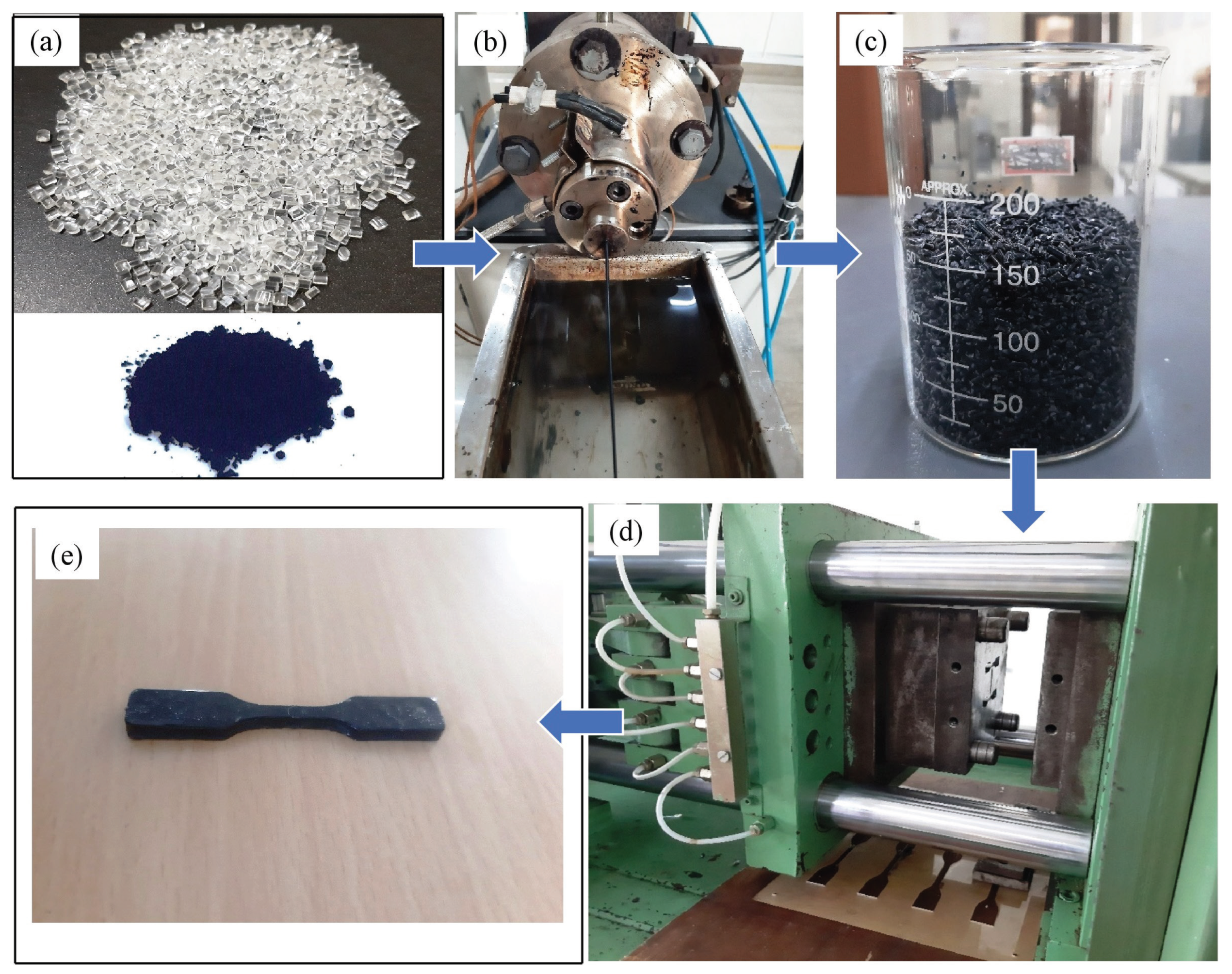
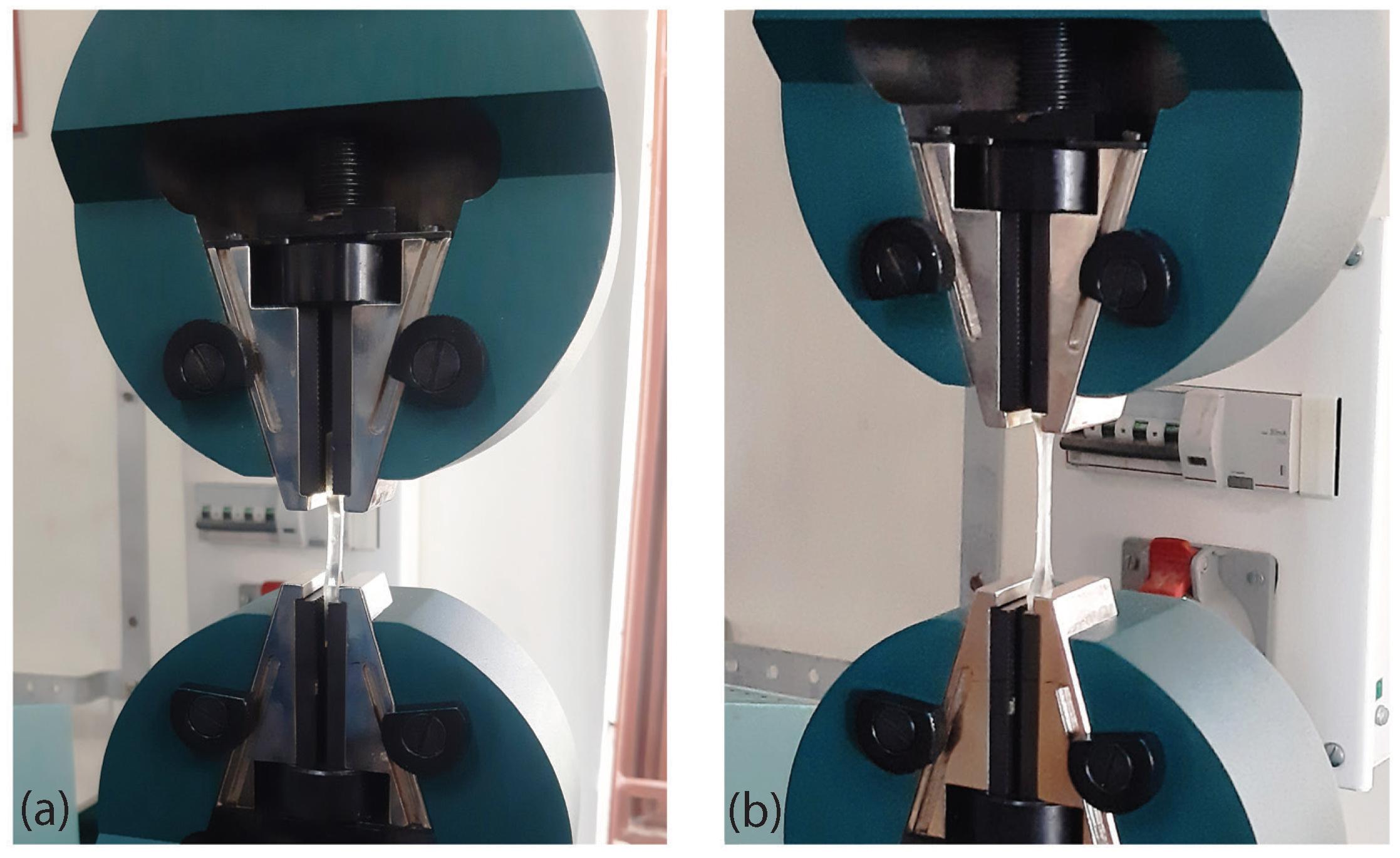


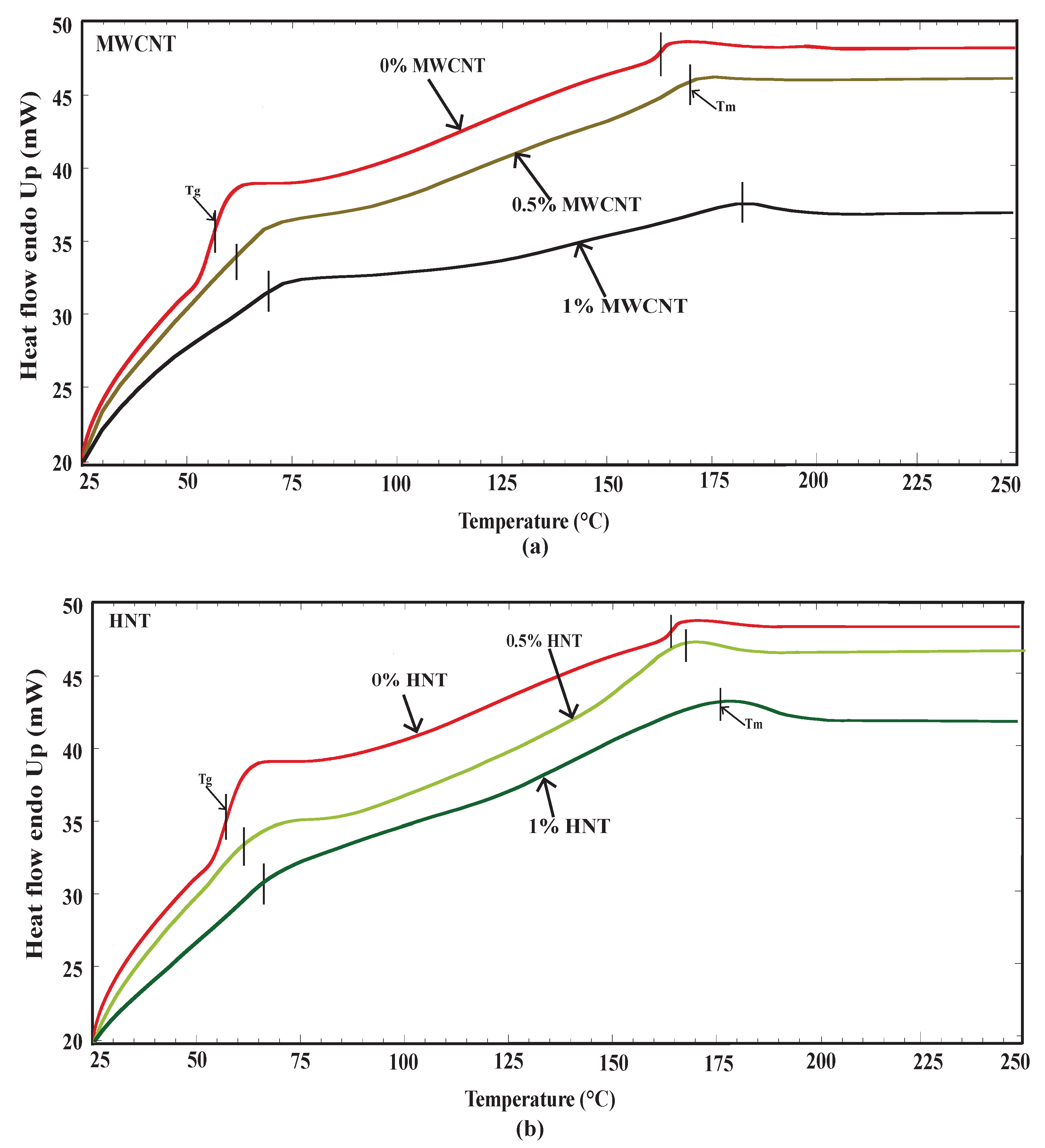
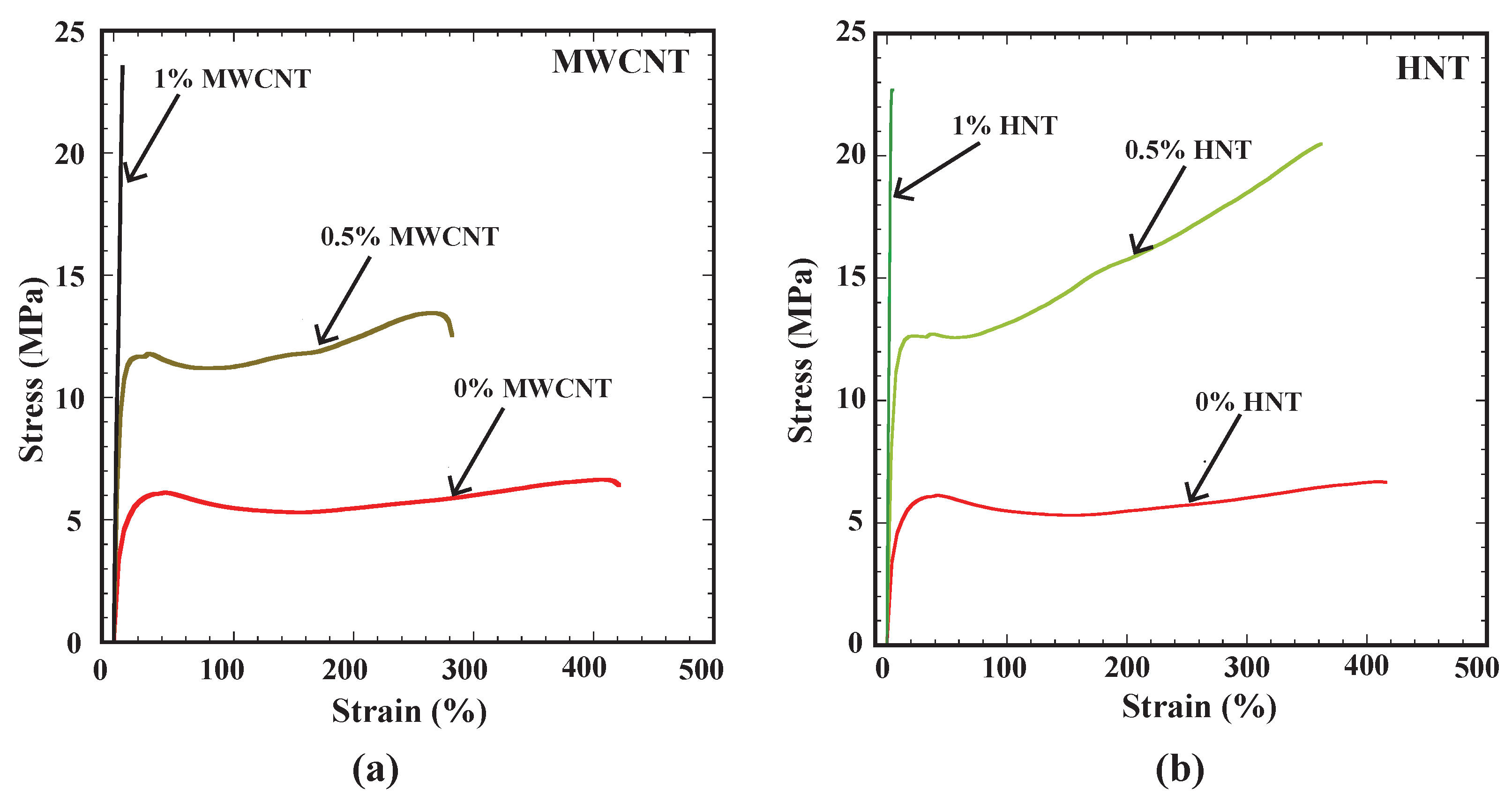
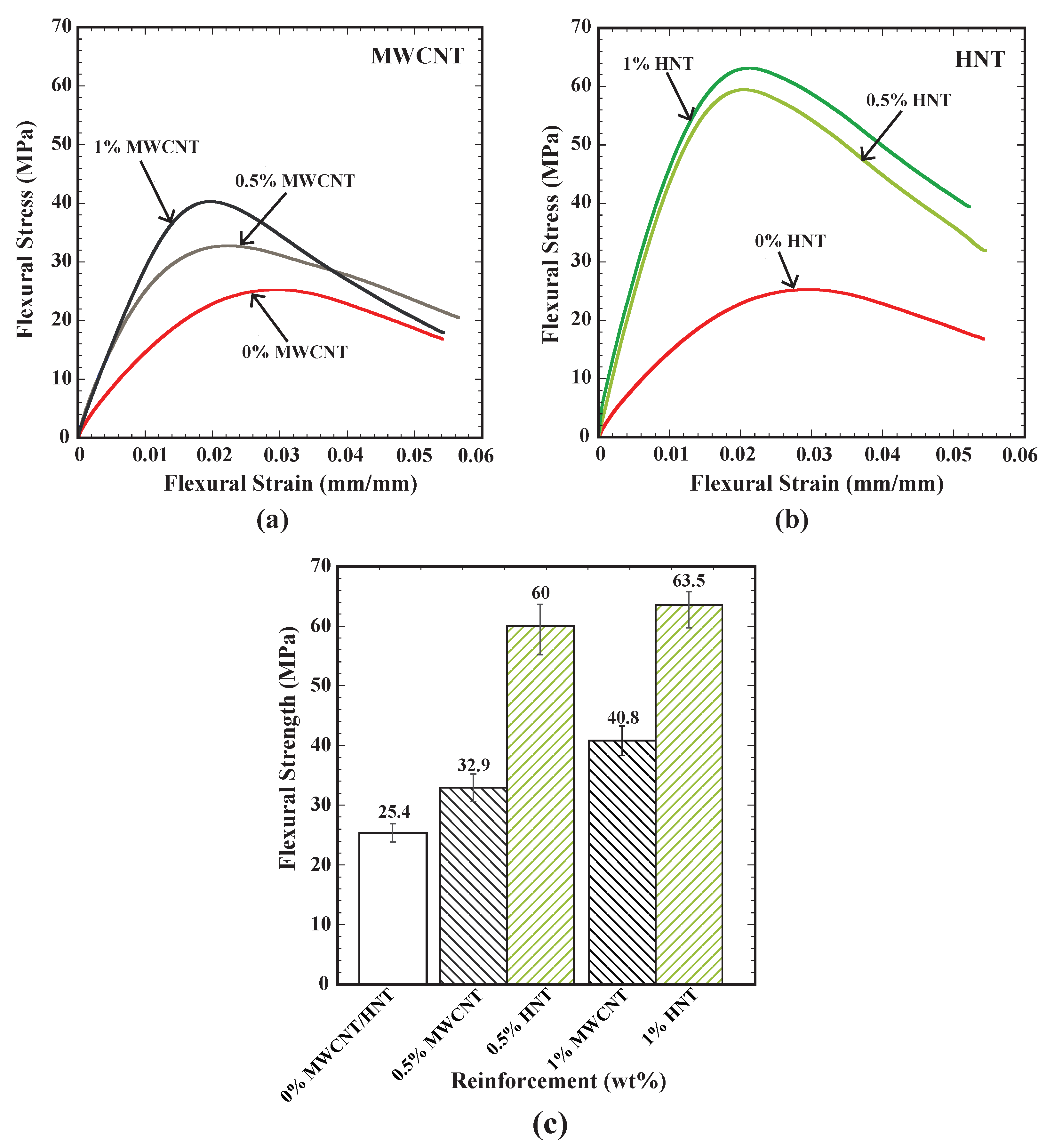

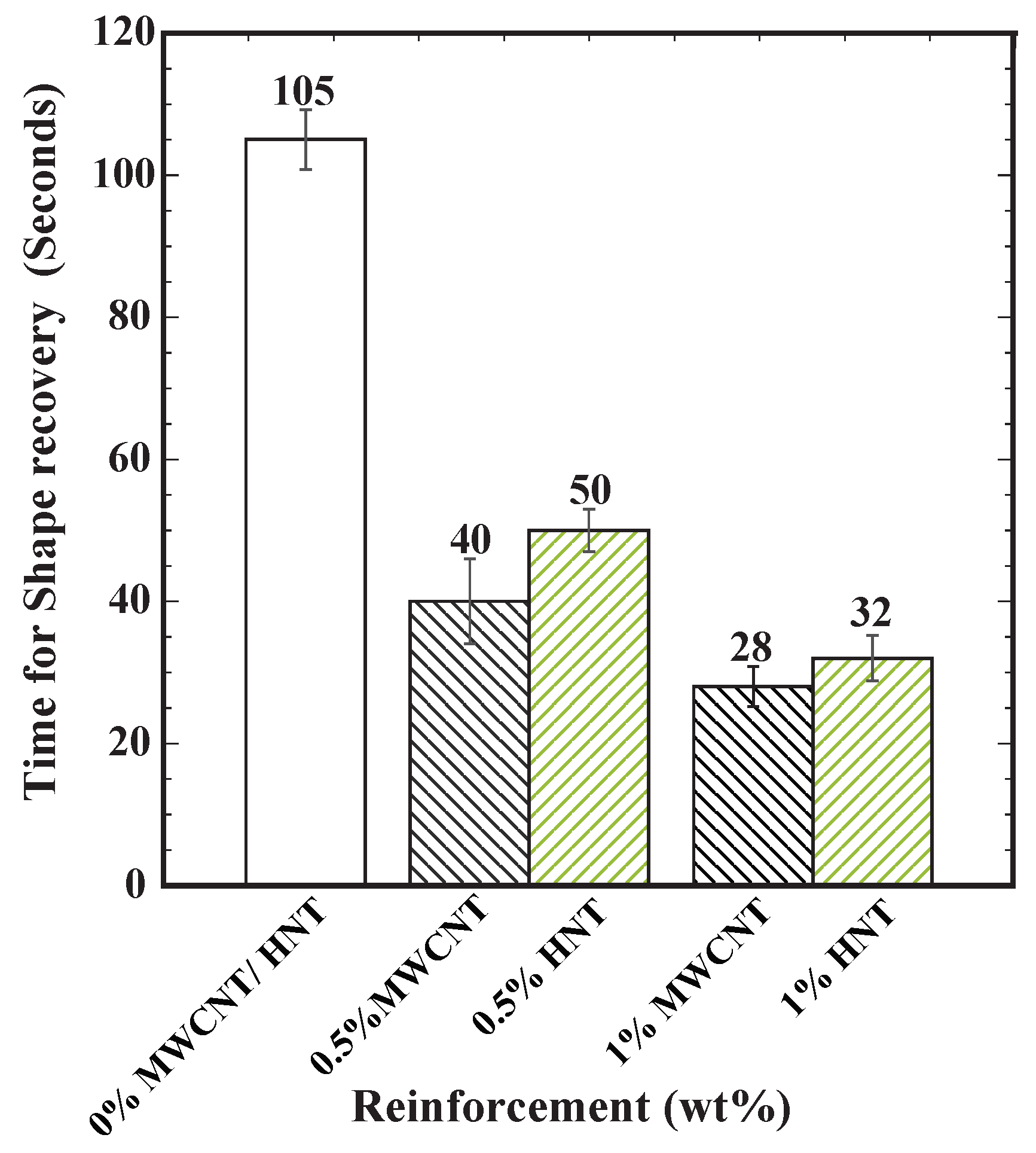
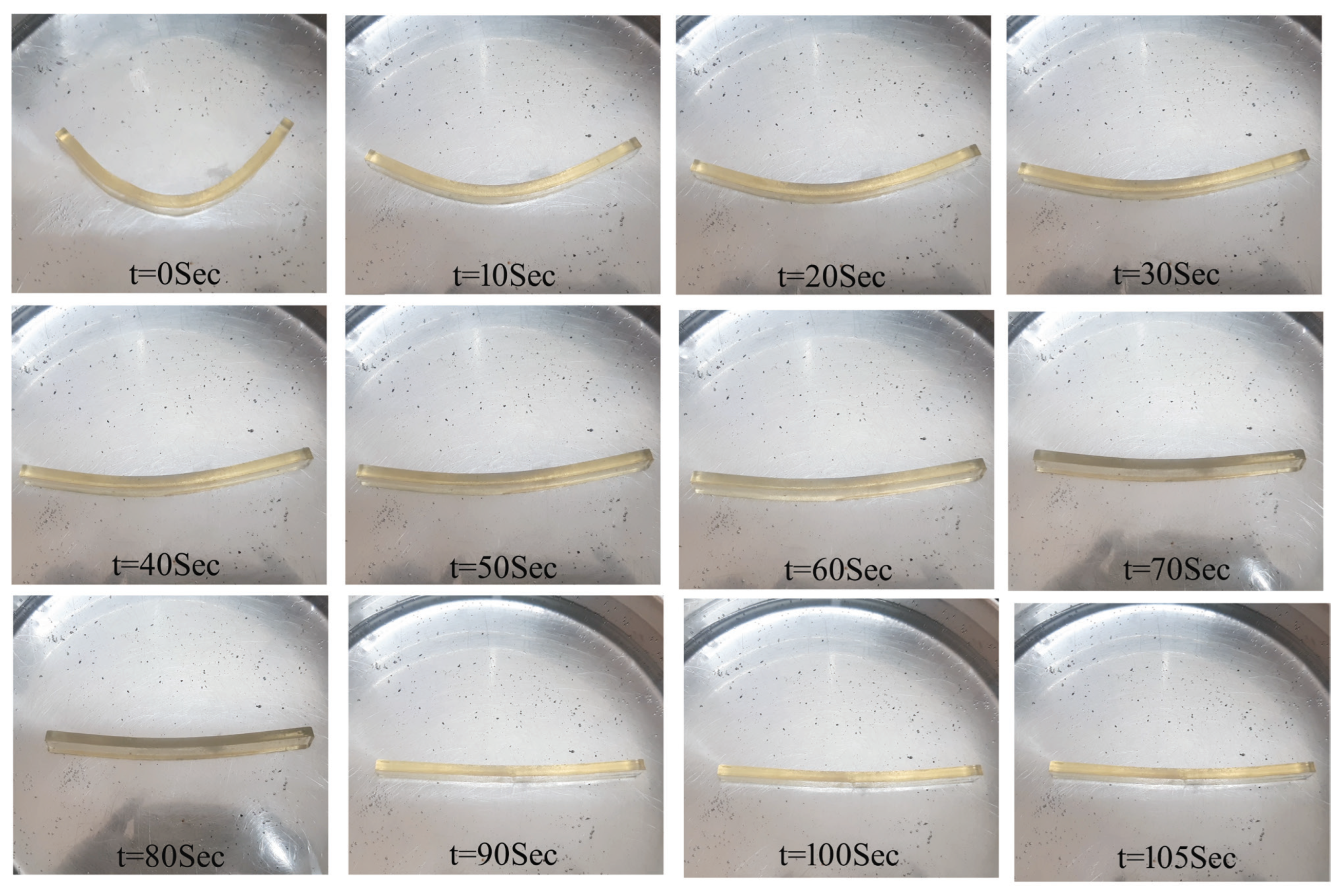
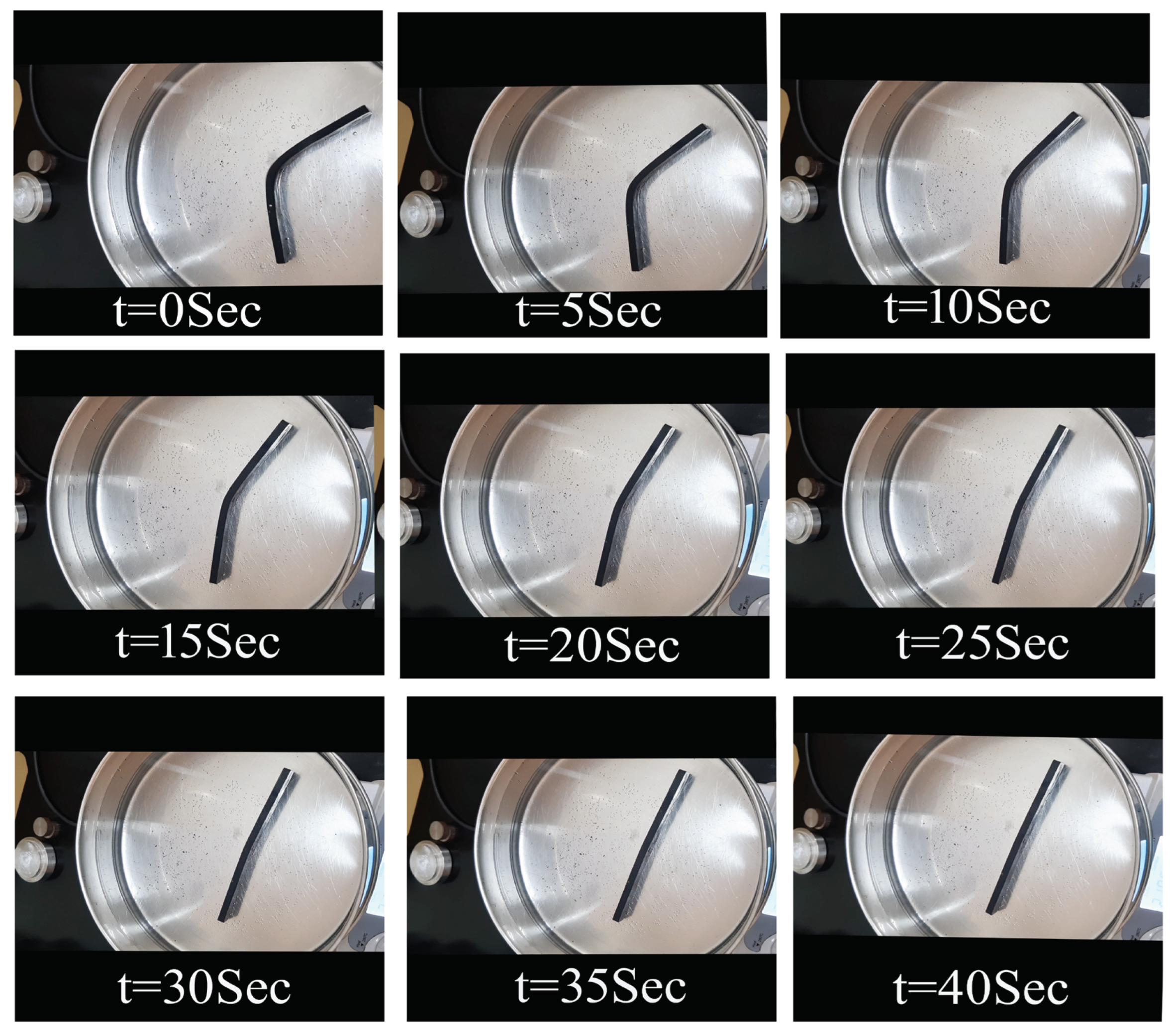
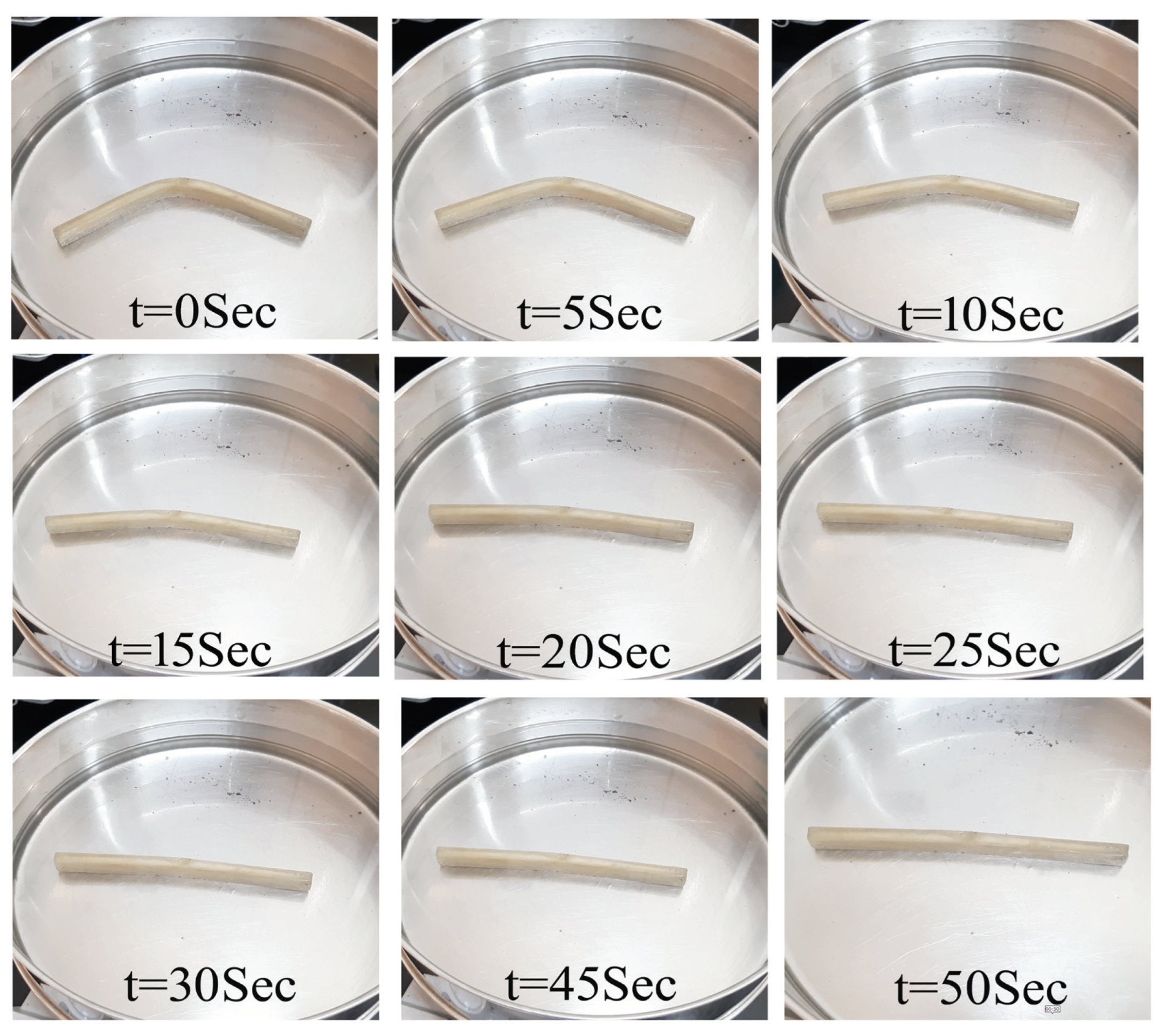
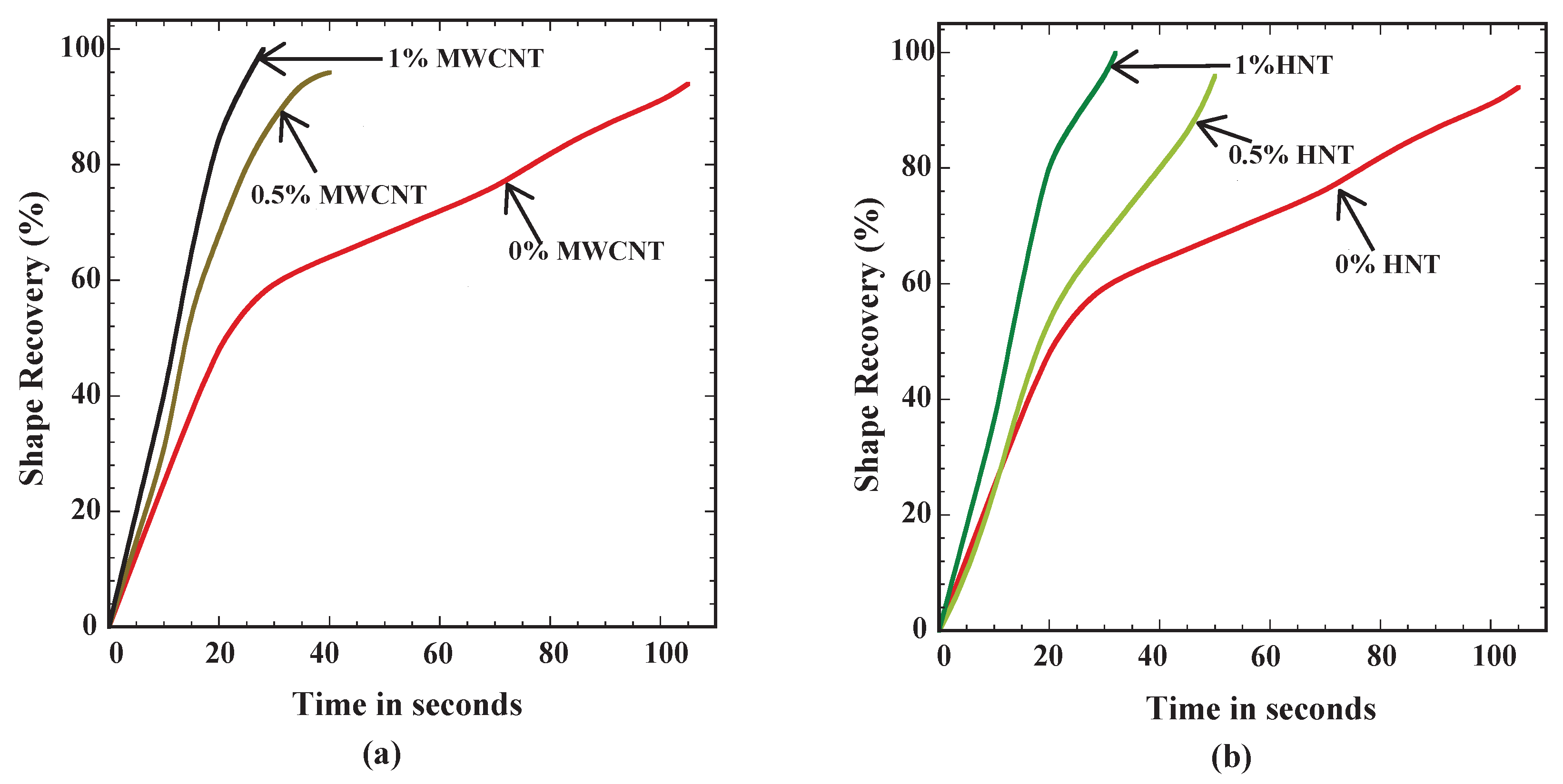
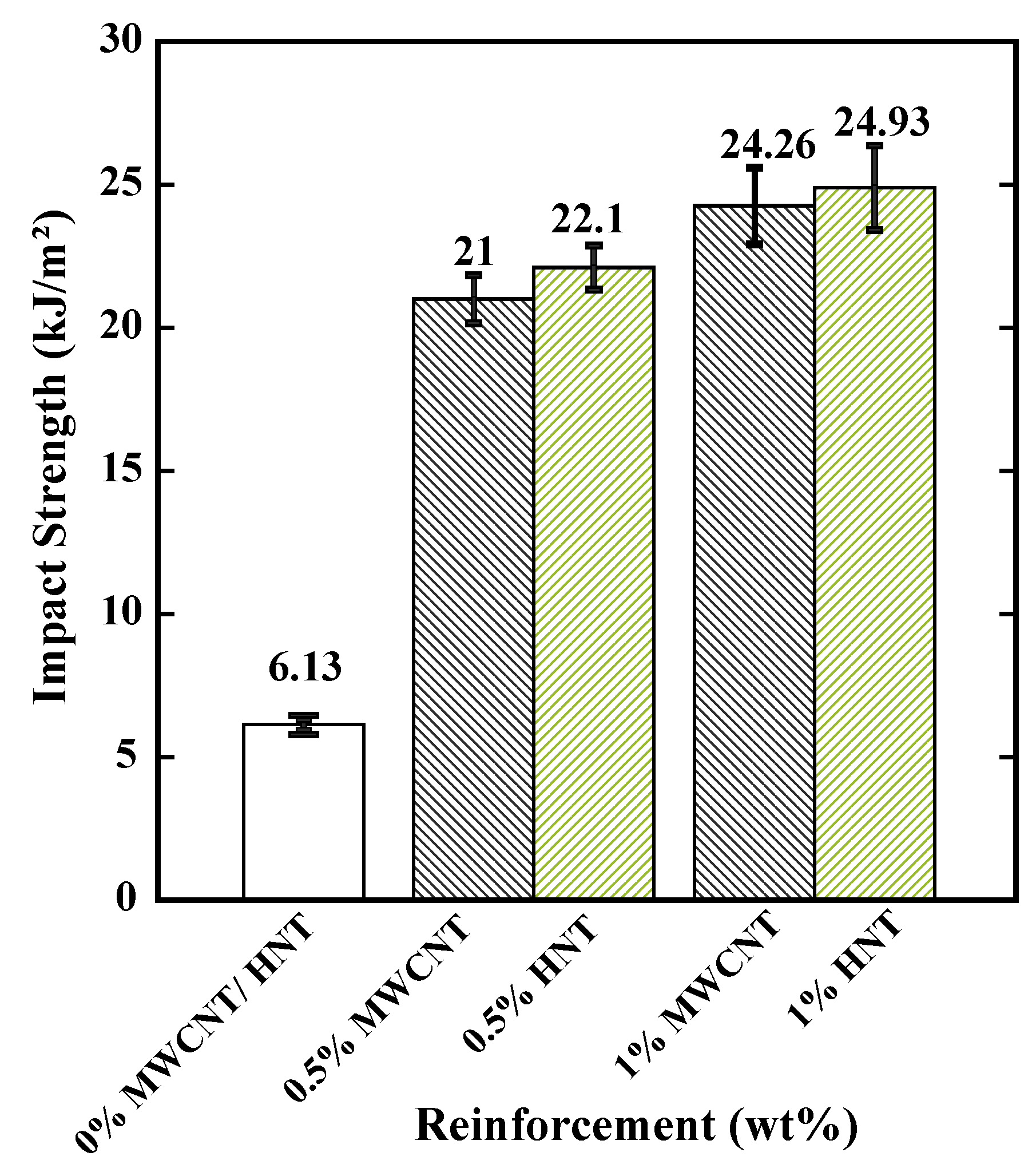
| Pure SMP | 0.5 wt% Reinforcement | 1 wt% Reinforcement | |||
|---|---|---|---|---|---|
| Type of reinforcement | MWCNTs | HNTs | MWCNTs | HNTs | |
| Tensile strength (MPa) | 6.7 | 13.6 | 22.4 | 23.5 | 22.7 |
| % of elongation | 424 | 284 | 362 | 7.23 | 6 |
Disclaimer/Publisher’s Note: The statements, opinions and data contained in all publications are solely those of the individual author(s) and contributor(s) and not of MDPI and/or the editor(s). MDPI and/or the editor(s) disclaim responsibility for any injury to people or property resulting from any ideas, methods, instructions or products referred to in the content. |
© 2023 by the authors. Licensee MDPI, Basel, Switzerland. This article is an open access article distributed under the terms and conditions of the Creative Commons Attribution (CC BY) license (https://creativecommons.org/licenses/by/4.0/).
Share and Cite
Namathoti, S.; Vakkalagadda, M.R.K. Mechanical and Shape Recovery Characterization of MWCNTs/HNTs-Reinforced Thermal-Responsive Shape-Memory Polymer Nanocomposites. Polymers 2023, 15, 710. https://doi.org/10.3390/polym15030710
Namathoti S, Vakkalagadda MRK. Mechanical and Shape Recovery Characterization of MWCNTs/HNTs-Reinforced Thermal-Responsive Shape-Memory Polymer Nanocomposites. Polymers. 2023; 15(3):710. https://doi.org/10.3390/polym15030710
Chicago/Turabian StyleNamathoti, Sivanagaraju, and Manikanta Ravindra Kumar Vakkalagadda. 2023. "Mechanical and Shape Recovery Characterization of MWCNTs/HNTs-Reinforced Thermal-Responsive Shape-Memory Polymer Nanocomposites" Polymers 15, no. 3: 710. https://doi.org/10.3390/polym15030710
APA StyleNamathoti, S., & Vakkalagadda, M. R. K. (2023). Mechanical and Shape Recovery Characterization of MWCNTs/HNTs-Reinforced Thermal-Responsive Shape-Memory Polymer Nanocomposites. Polymers, 15(3), 710. https://doi.org/10.3390/polym15030710






